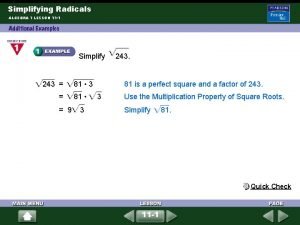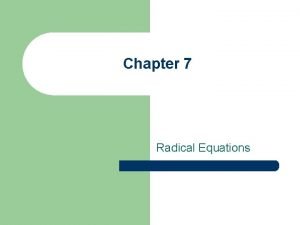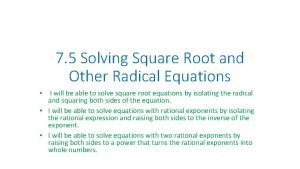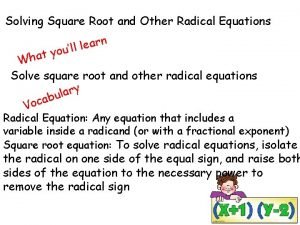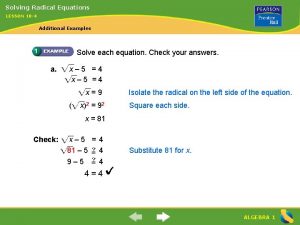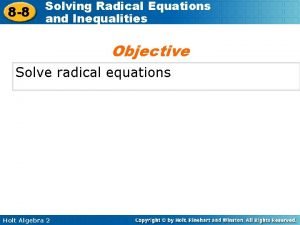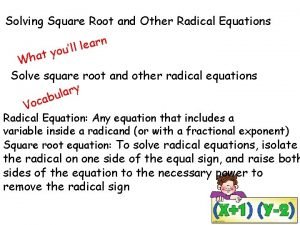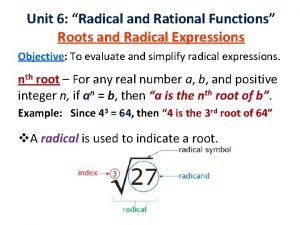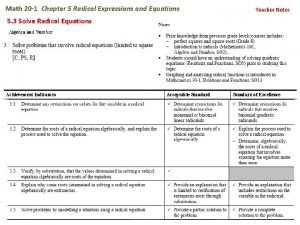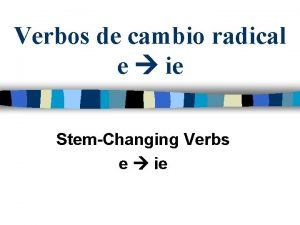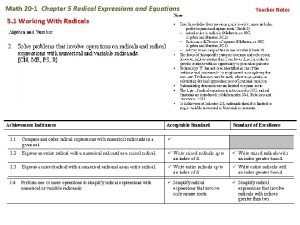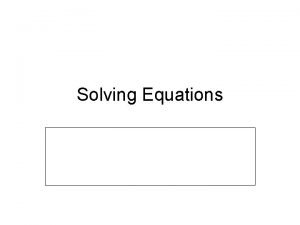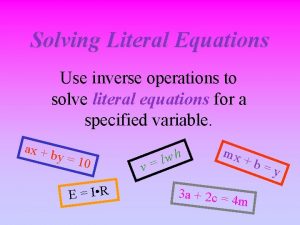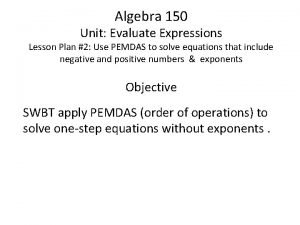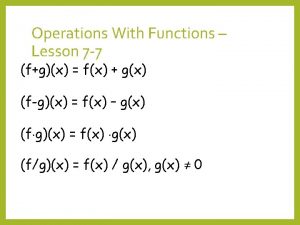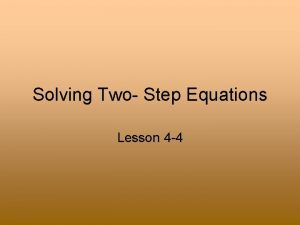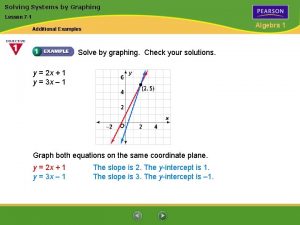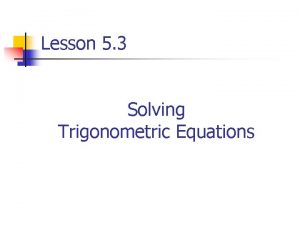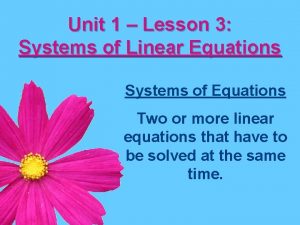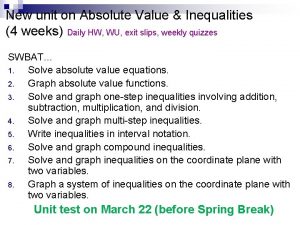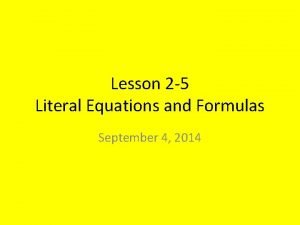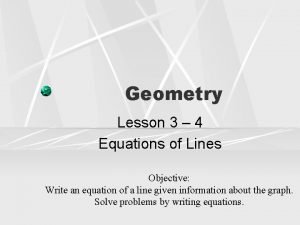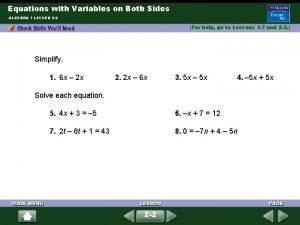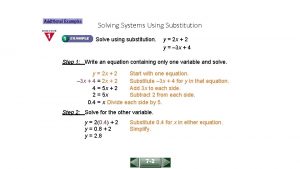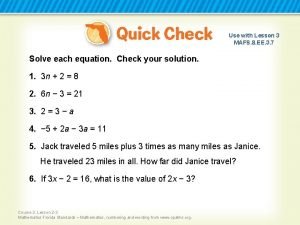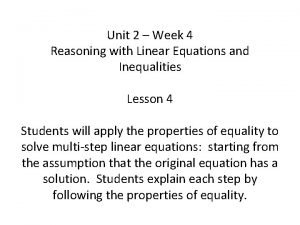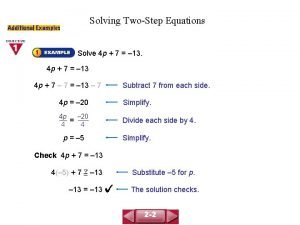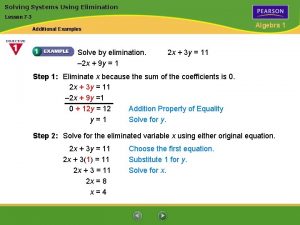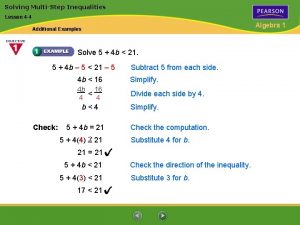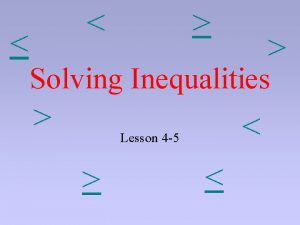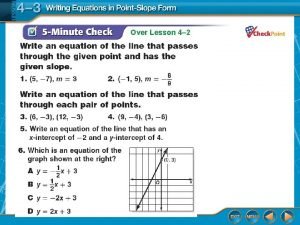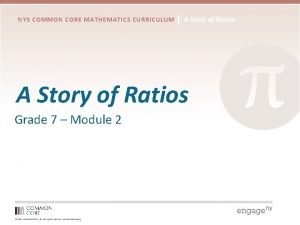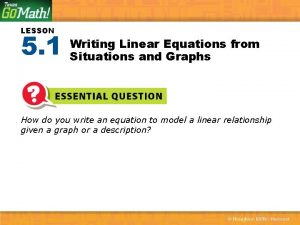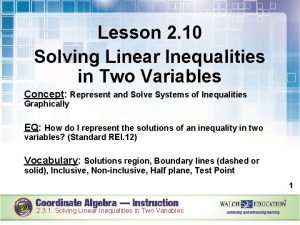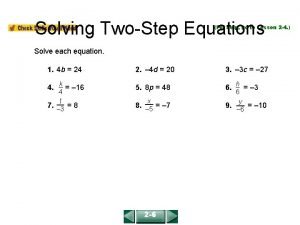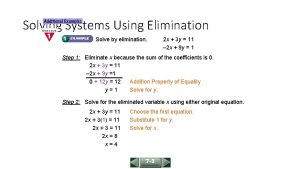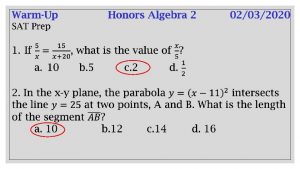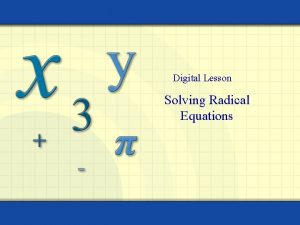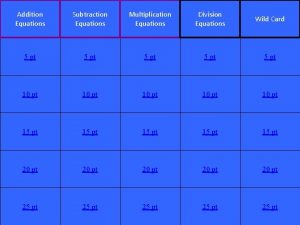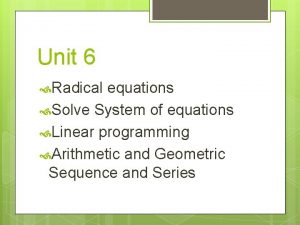Chapter 7 Radical Equations Lesson 7 1 Operations





 = f[g(x)] ▫ Plug in pg 1 Composition of Functions • [f o g](x) = f[g(x)] ▫ Plug in](https://slidetodoc.com/presentation_image_h2/0de6072df0161b1b4a780aff09476ad3/image-6.jpg)
 and [g o f](x) for f(x) pg 1 Examples 3. Find [f o g](x) and [g o f](x) for f(x)](https://slidetodoc.com/presentation_image_h2/0de6072df0161b1b4a780aff09476ad3/image-7.jpg)


























































- Slides: 65

Chapter 7 Radical Equations

Lesson 7. 1 Operations of Functions

pg 1 Operations with functions • (f + g)(x)= f(x) + g(x) • (f – g )(x) = f(x) – g(x) • (f · g)(x) = f(x) · g(x) • (f/g)(x) = f(x) , g(x) = 0 g(x)

pg 1 Examples 1. f(x)= x 2 – 3 x + 1 and g(x) = 4 x + 5 find a. (f + g)(x) b. (f – g)(x)

pg 1 2. f(x) = x 2 + 5 x – 1 and g(x) = 3 x – 2 find a. (f · g)(x) b. (f/g)(x)
 = f[g(x)] ▫ Plug in](https://slidetodoc.com/presentation_image_h2/0de6072df0161b1b4a780aff09476ad3/image-6.jpg)
pg 1 Composition of Functions • [f o g](x) = f[g(x)] ▫ Plug in the full function of g for x in function f
 and [g o f](x) for f(x)](https://slidetodoc.com/presentation_image_h2/0de6072df0161b1b4a780aff09476ad3/image-7.jpg)
pg 1 Examples 3. Find [f o g](x) and [g o f](x) for f(x) = x+3 and g(x) = x 2 + x – 1 4. Evaluate [f o g](x) =2 and [g o f](x) for x

TOD: Find the sum, difference, product and quotient of f(x) and g(x) 1. f(x) = x 2 + 3 g(x) = x – 4 Find [g o h](x) and [h o g](x) 2. g(x) = 2 x 3. h(x) = 3 x – 4 If f(x) = 3 x, g(x) = x + 7 and h(x) = x 2 find the following 4. f[g(3)] 5. g[h(-2)] 6. h[h(1)]

Lesson 7. 2 Inverse Functions and Relations

pg 2 Inverse Relations • Two relations are inverse relations if and only if one relation contains the element (a, b) the other relation contains the element (b, a) ▫ Example: Q and S are inverse relations Q = {(1, 2), (3, 4), (5, 6)} S = {(2, 1), (4, 3), (6, 5)}

pg 2 Examples 1. Find the inverse relation of {(2, 1), (5, 1), (2, -4)} 2. Find the inverse relation of {(-8, -3), (-8, -6), (-3, -6)}

pg 2 Property of Inverse Functions • Suppose f and f-1 are inverse functions. Then f(a) = b if and only if f -1 (b) = a v. To find the inverse of a function: 1. Replace f(x) with y 2. Switch x and y 3. Solve for y 4. Replace y with f-1(x) 5. Graph f(x) and f-1(x) on the same coordinate plane

pg 2 To Graph a function and it’s inverse 1. Make an x/y chart for f(x) then graph the points and connect the dots 2. Make an x/y chart for f-1(x) by switching the x and y coordinates and then graph and connect the dots - The graphs should be reflections of one another over the line y=x

Examples 3. Find the inverse of and then graph the function and its inverse pg 3

pg 3 4. Find the inverse of and then graph the function and its inverse f(x) = 2 x - 3

pg 3 Inverse Functions • Two functions f and g are inverse functions if and only if both of their compositions are the identity function. [f o g](x) = x and [g o f](x) = x

pg 3 5. Determine if the functions are inverses

pg 3 6. Determine if the functions are inverses

Lesson 7. 3 Square Root Functions and Inequalities

Square Root Functions • Definition: when a function contains a square root of a variable • The inverse of a quadratic function (starts with x 2) is a square root function only if the range has no negative numbers!! pg 4

pg 4 Parent Functions

pg 4 Graphing Square Root Functions 1. Find the domain. The radicand (the stuff inside the square root) cannot be negative so take whatever is inside and make it greater than or equal to 0 and solve. 2. Plug the x value you found back in and solve for y. 3. Make a table starting with the ordered pair you found in steps 1 & 2. Graph. 4. State the range.

Examples 1. Graph. State the domain, range, and x- and y- intercepts. pg 5

2. Graph. State the domain, range, and x- and y- intercepts. pg 5

3. Graph. State the domain, range, and x- and y- intercepts pg 5

pg 6 Square Root Inequalities • Follow same steps as an equation to graph but add last step of shading. • Remember rules for solid and dotted lines!!

Examples 4. Graph pg 6

5. Graph pg 6

6. Graph pg 6

7. Graph pg 6

7. 4 Nth Roots

pg 7 Nth Roots

pg 7 Symbols and Vocabulary Radical Sign index Radicand

More Vocabulary • Principal Root: the nonnegative root ▫ Example: 36 has two square roots, 6 and -6 � 6 is the principal root because it is positive Other things to remember: - If the radical sign has a – in front of it this indicates the opposite of the principal square root - If the radical has a ± in front of it then you give both the principal and the opposite principal roots pg 7

Summary of Nth Roots n even odd b>0 b<0 one positive root, one negative root no real roots one positive root, no negative root no positive roots, one negative root b=0 One real root = 0 pg 7

Examples pg 8

Your turn… pg 8

More things to remember… • When you find the nth root of an even power and the result is an odd power, you must take the absolute value of the result to ensure that the answer is nonnegative ▫ pg 8

Examples Using Absolute Values pg 8

7. 5 Operations with Radical Expressions

Review of Properties of Radicals Product Property Quotient Property If all parts of the radicand are positive - separate each part so that it has the nth root Ex: pg 9

pg 9 When is a radical simplified? -The nth root is as small as possible -The radicand has no fractions -There are no radicals in the denominator

Rationalizing the Denominator • If you have a fraction with a radical in the denominator you must rationalize the denominator, multiply the numerator and denominator by the square root in the denominator. pg 9

Examples pg 9

pg 10 Simplify all radicals then combine -Remember you can only combine like terms!

pg 10 Foil- then simplify

pg 10 Multiply by the conjugate- then simplify

7. 6 Rational Exponents

Fractions, are our Friends! • What do we do when we have a fraction as an exponent? ▫ Change it into a radical v The denominator of becomes the index of the radical v The numerator becomes the power for the radicand v Ex: = pg 11

Examples pg 11

Generalization for numerator greater than 1 v. The denominator becomes the index for the radical (nth root) If the numerator is bigger than 1: v. The numerator becomes the power for the nth root of the radicand v. Ex: = = = pg 11

pg 12 Examples

pg 12

pg 12

7. 7 Solving Radical Equations and Inequalities

pg 13 Vocabulary • Radical equations/inequalities: equations/inequalities that have variables in the radicands • Extraneous Solution: when you get a solution that does not satisfy the original equation.

pg 13 Steps to solve radical equations/inequalities 1. Isolate the radical. ▫ If there is more than one, isolate the radical that has the most stuff in it first! 2. Raise both sides to the power that will eliminate the radical. ▫ If there is more than one radical you will have to repeat this step until there are no more radicals in the problem 3. Solve for the variable. 4. Test solutions to check for extraneous roots.

pg 13 Solve Radical Equations

pg 13

pg 14

pg 14

pg 14 Day #2 Now let’s look at inequalities • Steps to Solve a radical inequality 1. Identify the values of x for which the root is defined. 2. Solve given inequality by isolating and then eliminating the radical 3. Test values to confirm your solution (use a table to do this) 4. Graph solution on a number line. (Remember open and closed dots)

pg 14

pg 14

pg 14
 Unit 6 test radical functions
Unit 6 test radical functions 11-1 simplifying radical expressions answers
11-1 simplifying radical expressions answers Lesson 7 - graphing radical equations and inequalities
Lesson 7 - graphing radical equations and inequalities Lesson 5 solving square root and other radical equations
Lesson 5 solving square root and other radical equations What is a mixed radical
What is a mixed radical Entire radical form
Entire radical form Root of an equation
Root of an equation 10-4 skills practice radical equations answers with work
10-4 skills practice radical equations answers with work How to solve a radical inequality
How to solve a radical inequality Solve radical inequalities
Solve radical inequalities Equations with rational exponents
Equations with rational exponents Solving radical equations
Solving radical equations Solving radical equations and inequalities
Solving radical equations and inequalities Radical equation examples
Radical equation examples Solving square root and other radical equations quick check
Solving square root and other radical equations quick check Radical and rational equations
Radical and rational equations Radical equations and inequalities
Radical equations and inequalities Solving radical equations
Solving radical equations Solving radical equations with variables on both sides
Solving radical equations with variables on both sides What is radical 20
What is radical 20 Sleeptu
Sleeptu Entire radical form
Entire radical form Solve equations using inverse operations
Solve equations using inverse operations Literal equations summary
Literal equations summary Rectangular equations to polar equations
Rectangular equations to polar equations Translating chemical equations
Translating chemical equations Chapter 1 lesson 1 your total health lesson 1 quiz
Chapter 1 lesson 1 your total health lesson 1 quiz Radical days of the revolution
Radical days of the revolution Order of operations lesson plan
Order of operations lesson plan 7-7 operations on functions answers
7-7 operations on functions answers How to count sig figs in scientific notation
How to count sig figs in scientific notation Sentence combining calculator
Sentence combining calculator Faceing math lesson 4 solving two step equations
Faceing math lesson 4 solving two step equations Lesson 7 solve systems of equations by graphing
Lesson 7 solve systems of equations by graphing Lesson 26 solving rational equations
Lesson 26 solving rational equations Toxic reactions chemical equations worksheet answers
Toxic reactions chemical equations worksheet answers Trigonometric formulas
Trigonometric formulas Quadratic formula
Quadratic formula Unit 1 lesson 3 review of linear systems
Unit 1 lesson 3 review of linear systems Lesson 4-1 absolute value equations
Lesson 4-1 absolute value equations Lesson 7-2 equations with rational numbers
Lesson 7-2 equations with rational numbers Lesson 7 understanding equations
Lesson 7 understanding equations Slope intercept form lesson 4
Slope intercept form lesson 4 3-4 equations of lines answer key
3-4 equations of lines answer key Lesson 2-5 solving literal equations for a variable
Lesson 2-5 solving literal equations for a variable 3-4 equations of lines
3-4 equations of lines Lesson 7 write equations
Lesson 7 write equations Lesson 2-2 equations with variables on both sides answers
Lesson 2-2 equations with variables on both sides answers Lesson 7 how to solve basic algebraic equations
Lesson 7 how to solve basic algebraic equations Lesson 1-3 absolute value equations and inequalities
Lesson 1-3 absolute value equations and inequalities Lesson 3 linear equations in x
Lesson 3 linear equations in x Unit 2 lesson 4 solving equations
Unit 2 lesson 4 solving equations Lesson 2-2 solving one-step equations
Lesson 2-2 solving one-step equations Unit 7 lesson 3 solving systems using elimination
Unit 7 lesson 3 solving systems using elimination Lesson 4 - solving linear equations and inequalities
Lesson 4 - solving linear equations and inequalities 1-5 solving inequalities answers
1-5 solving inequalities answers Sadmeg
Sadmeg Lesson 8-2 writing equations
Lesson 8-2 writing equations Lesson 23 solving equations using algebra
Lesson 23 solving equations using algebra Lesson 5 - graphing linear equations and inequalities
Lesson 5 - graphing linear equations and inequalities Lee charges $3 for a basket
Lee charges $3 for a basket Lesson 3-4 solving matrix equations
Lesson 3-4 solving matrix equations Lesson 2-1 graphing two-variable equations
Lesson 2-1 graphing two-variable equations Writing and solving equations lesson 2-1
Writing and solving equations lesson 2-1 Lesson 2 solve two step equations
Lesson 2 solve two step equations Lesson 7 how to solve basic algebraic equations
Lesson 7 how to solve basic algebraic equations

